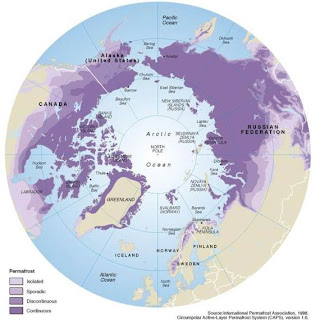 But for Alexander Chikmaryov, who works in the state-run meteorological station at the Marresale port on the Kara Sea, around 500 km north of the Arctic Circle, global warming does not exist: “Whoever made that ridiculous idea up spends too much time at home,” said the 58-year old, surveying an exposed strip of permafrost from a mud bank that has collapsed, giving way to streamlets littered with goose skeletons.
But for Alexander Chikmaryov, who works in the state-run meteorological station at the Marresale port on the Kara Sea, around 500 km north of the Arctic Circle, global warming does not exist: “Whoever made that ridiculous idea up spends too much time at home,” said the 58-year old, surveying an exposed strip of permafrost from a mud bank that has collapsed, giving way to streamlets littered with goose skeletons.
Geographer Fyodr Romanenko of Moscow State University agreed there is no proof human activity has damaged the environment. The up to 4 degree Celsius rise felt across parts of the Arctic in the last 30 years could be part of millennia-old fluctuating weather patterns, he said. Other researchers disagree, saying the frozen, sparsely populated Yamal region 2,000 km northeast of Moscow holding a quarter of the world’s known gas reserves and home to the Nenets tribespeople, is testament to climate change.
According to a paper in the scientific journal Global Change Biology published by Bruce Forbes of Finland’s Arctic Centre, rising temperatures are making the Arctic tundra greener, adding significant growth of shrub willows over the last thirty years.

The world’s largest country has a thick band of permafrost — which contains organic matter whose microbes can emit the powerful greenhouse gas, methane — stretching from Murmansk near Finland to the far eastern region of Chukotka near Alaska.
Environmentalists fear melting permafrost from rising temperatures will accelerate global warming. Russia — which has permafrost covering 60 percent of its land — most likely holds the world’s biggest methane threat. By 2050, vast amounts of methane will “explode into the air” from Russia’s melting permafrost, Chuprov, head of the Russian energy unit at environmental group Greenpeace, said.
Atmospheric methane concentrations, 1985-2008, with the IPCC methane projections overlaid
(adapted from: Dlugokencky et al., 2009)
The United Nations panel of climate scientists says warming is happening faster in the Arctic than the global average. As reflective snow and ice retreats, it exposes darker ground and water that soaks up ever more heat.




The Arctic Methane Emergency Group have been warning us about this for years and it is now a given. The game is up and we are all going down with it.
ReplyDelete